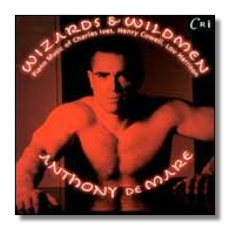
The Internet's Premier Classical Music Source
Related Links
- Latest Reviews
- More Reviews
-
By Composer
-
Collections
DVD & Blu-ray
Books
Concert Reviews
Articles/Interviews
Software
Audio
Search Amazon
Recommended Links
Site News
 CD Review
CD Review
Wizards & Wildmen

- Charles Ives:
- The Celestial Railroad
- Improvisations (3) for Piano
- Sonata for Piano #2 "Concord, Mass 1840-60": 3rd movement "The Alcotts"
- Studies (23) for Piano: #22, Andante maestoso - Allegro vivace
- Henry Cowell:
- Aeolian Harp
- Dynamic Motion:
- Encore #1, What's This
- Encore #2, Amiable Conversation
- Encore #3, Advertisement
- Encore #4, Antinomy
- Encore #5, Time Table
- Exultation
- The Banshee
- The Lilt of the Reel
- Tiger
- Lou Harrison:
- Homage to Milhaud
- Largo Ostinato
- Main Rain
- Prélude and Sarabande for Piano
- Sonata for Piano #3
- Waltzes (3)
Anthony de Mare, piano
CRI CD 837 DDD 78:18
It was an imaginative and valid idea to program the music of these three composers on a single CD. Ives, the oldest of the three, was born in 1874, and began his musical experimentation in his teen years, encouraged by his equally independent-minded father. Cowell was born in 1897. He promoted and then published Ives' music, in spite of colleagues who dismissed Ives as a "crank." Cowell's own work with non-traditional methods of playing the piano prefigured John Cage's compositions for prepared piano. Harrison was from a later generation yet – he was born in 1917. Harrison studied with Cowell in the mid-1930s, and quickly became interested in his mentor's mentor. Ives was delighted with Harrison's zeal, which reached a climax in 1946, when Harrison conducted the long-delayed première of Ives' Third Symphony, a work that subsequently won the Pulitzer Prize. Unlike Ives and Cowell, Harrison has not written extensively for the piano, although he was a formidable performer on this instrument from early on. Unsurprisingly, several première recordings are claimed on this disc, all of music by Harrison. These include his Third Piano Sonata, a Prélude for Grandpiano [sic] (to Henry Cowell), Homage to Milhaud, Largo Ostinato, and a Saraband. These works were written in 1937-38, with the exception of the 36-second Homage to Milhaud, which was written in 1948.
The best of Ives' piano music is in the sonatas, which obviously were not included here because of their length. The moving third movement ("The Alcotts") from the "Concord" Sonata is here, however, and de Mare plays it with the requisite plain-spokenness. Also included is the visionary The Celestial Railroad, which was derived from the "Hawthorne" movement of the "Concord" Sonata, and in turn formed the basis of the Scherzo from the Fourth Symphony. It is an incredibly complicated work, but de Mare keeps its strands untangled and communicative. Three Improvisations from 1938 and a Study #22 from circa 1909 are chips from the composer's workbench. Unlike many so-called "improvisations," Ives' are just that; he played them in a recording studio in 1938, and they were transcribed to paper later on by other hands.
On the other hand, most of Cowell's major piano works are here, including the famous Aeolian Harp (1923) and The Banshee (1925). Here, the pianist is required to strum the piano's strings with his fingers. In the latter work, a keening, screaming effect is created, as befits the subject. Cowell's music ranges from the quiet and poetic (Aeolian Harp) to the brutality of Tiger (1928) and the breakthrough Dynamic Motion (1916), which both make liberal use of cluster chords.
De Mare triumphs in a long and demanding program; he even sings in a piece by Harrison called May Rain. Undoubtedly his technique and interpretations are impressive, but even more impressive is the program itself, and the intellect that assembled it. The excellent annotations are by Bob Gilmore, and the engineering – not overly bright – is by Judith Sherman.
Copyright © 2001, Raymond Tuttle


















